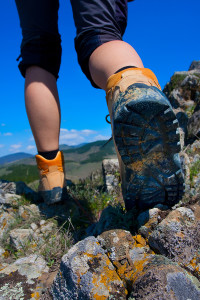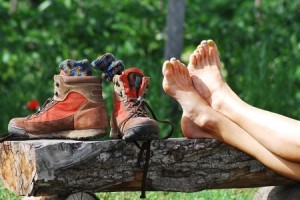 For the next few blogs I am going to discuss how to get happy, strong and healthy feet for the Camino (Felices, sanos y fuertes pies en el Camino). It’s very important to get your feet strong, stretched and ready to walk the long distances along the Way of St James to Santiago de Compostella.
For the next few blogs I am going to discuss how to get happy, strong and healthy feet for the Camino (Felices, sanos y fuertes pies en el Camino). It’s very important to get your feet strong, stretched and ready to walk the long distances along the Way of St James to Santiago de Compostella.
The function and anatomy of our feet is complex:
1) The feet are our connection with the Earth forming a weight bearing foundation for our body. The feet balance weight distribution and alignment with the body that lines up over them.
2) The feet and toes bear and propel body weight during movement. The feet balance the body during movement and changes in body position. The feet enable mobility, direction and balance. The toes help with balance and propulsion during movement.
Continue reading →


 In 9 weeks (May 16) Marta and I will be leaving for our 40 day pilgrims walking adventure on the Camino de Santiago. As we finalize our preparation I am taking the time to be good to my feet. It has been a long winter in heavy boots and socks and my feet need dedicated exercise and massage to remove the tension, strain and tenderness that has accumulated. Yoga is a great way to take care of your feet. Your feet will get a healthy workout in many yoga postures. Being barefoot and focusing on balancing weight distribution and body alignment is just the start.
In 9 weeks (May 16) Marta and I will be leaving for our 40 day pilgrims walking adventure on the Camino de Santiago. As we finalize our preparation I am taking the time to be good to my feet. It has been a long winter in heavy boots and socks and my feet need dedicated exercise and massage to remove the tension, strain and tenderness that has accumulated. Yoga is a great way to take care of your feet. Your feet will get a healthy workout in many yoga postures. Being barefoot and focusing on balancing weight distribution and body alignment is just the start. For the next few blogs I am going to discuss how to get happy, strong and healthy feet for the Camino (Felices, sanos y fuertes pies en el Camino). It’s very important to get your feet strong, stretched and ready to walk the long distances along the Way of St James to Santiago de Compostella.
For the next few blogs I am going to discuss how to get happy, strong and healthy feet for the Camino (Felices, sanos y fuertes pies en el Camino). It’s very important to get your feet strong, stretched and ready to walk the long distances along the Way of St James to Santiago de Compostella. I have been a program / project manager most of my working career which means an obsessive focus on planning. This of course runs over into my personal life and I have a Microsoft Project plan, as well as several “To Do” and outfitting lists that I am tracking. Below is my final 14 week Master “To Do” list for my Camino trail planning with Completion dates. All this planning has helped reduce my level of Camino Readiness anxiety.
I have been a program / project manager most of my working career which means an obsessive focus on planning. This of course runs over into my personal life and I have a Microsoft Project plan, as well as several “To Do” and outfitting lists that I am tracking. Below is my final 14 week Master “To Do” list for my Camino trail planning with Completion dates. All this planning has helped reduce my level of Camino Readiness anxiety. It has been a solid 2 months of walking in nasty winter conditions of varying cold arctic winds, heavy snow, ice storms, and slippery, dangerous surfaces. Last week I had an “I hate winter meltdown’ caused by feeling like an arctic vampire; living without sunlight and warmth and considered moving south. It was time to recalibrate, get perspective and put a positive spin on the winter blues. After all I am Canadian, and there are still 2 months until spring so I better “get a grip” and remember why I am training in these harsh conditions in the first place – to prepare me for the endurance required on the Camino!
It has been a solid 2 months of walking in nasty winter conditions of varying cold arctic winds, heavy snow, ice storms, and slippery, dangerous surfaces. Last week I had an “I hate winter meltdown’ caused by feeling like an arctic vampire; living without sunlight and warmth and considered moving south. It was time to recalibrate, get perspective and put a positive spin on the winter blues. After all I am Canadian, and there are still 2 months until spring so I better “get a grip” and remember why I am training in these harsh conditions in the first place – to prepare me for the endurance required on the Camino!
 As I look ahead to 2014, I marvel that it will be the Year that I celebrate turning 60 and becoming a true pilgrim (a wanderer or traveler) for 40 days of walking and exploring the Camino Santiago de Compostela. Last year at this time I had no plans for walking the Camino. I was originally planning a 2 week trip to the North West Territories with friends to celebrate my 60th. In the early spring I had a change of heart. I cannot remember why the Camino Trail became my new travel choice but my friend and fellow walker Marta was as excited as I was and the decision was firmed up. I am proud of how far I have progressed in 2013 on my training and preparation for my Camino sojourn.
As I look ahead to 2014, I marvel that it will be the Year that I celebrate turning 60 and becoming a true pilgrim (a wanderer or traveler) for 40 days of walking and exploring the Camino Santiago de Compostela. Last year at this time I had no plans for walking the Camino. I was originally planning a 2 week trip to the North West Territories with friends to celebrate my 60th. In the early spring I had a change of heart. I cannot remember why the Camino Trail became my new travel choice but my friend and fellow walker Marta was as excited as I was and the decision was firmed up. I am proud of how far I have progressed in 2013 on my training and preparation for my Camino sojourn. I have been training and walking in the snow using trekking poles for the last few weeks to prepare for the Camino de Santiago next year. It is not formally winter yet here in Canada, but the cold and snowy conditions are definitely here, and are early. I think that winter training will prepare me for any harsh weather conditions on the Camino trail. Mental toughness and conditioning are required to deal with:
I have been training and walking in the snow using trekking poles for the last few weeks to prepare for the Camino de Santiago next year. It is not formally winter yet here in Canada, but the cold and snowy conditions are definitely here, and are early. I think that winter training will prepare me for any harsh weather conditions on the Camino trail. Mental toughness and conditioning are required to deal with: In this blog post I was planning to write about my shopping search for Trekking poles. However the last 2 weekends have been a snow fest and I have not been out shopping. This is unfortunate since the more it snows, the more I need those walking poles. During my last walk I found a tree branch and used that as a walking pole to help me trudge through the snow on the Trans Canada Trail. Instead I will write about my other major exercise commitment for my Camino Santiago de Compostella training in the form of Yoga warm up and cool down poses for long distance walking.
In this blog post I was planning to write about my shopping search for Trekking poles. However the last 2 weekends have been a snow fest and I have not been out shopping. This is unfortunate since the more it snows, the more I need those walking poles. During my last walk I found a tree branch and used that as a walking pole to help me trudge through the snow on the Trans Canada Trail. Instead I will write about my other major exercise commitment for my Camino Santiago de Compostella training in the form of Yoga warm up and cool down poses for long distance walking. Now that I am training with my backpack and hiking boots on longer distances and varied terrain trails, it is time to add trekking poles to my training gear. I was debating when to start training with the trekking poles, but the first winter snow, and the additional weight of my backpack convinced me to start shopping for new poles. When I sat down and evaluated the benefits of using walking poles it was a “no-brainer” decision. The 5 benefits of Trekking poles are:
Now that I am training with my backpack and hiking boots on longer distances and varied terrain trails, it is time to add trekking poles to my training gear. I was debating when to start training with the trekking poles, but the first winter snow, and the additional weight of my backpack convinced me to start shopping for new poles. When I sat down and evaluated the benefits of using walking poles it was a “no-brainer” decision. The 5 benefits of Trekking poles are:

 In a
In a 
 I recently had a comment submitted asking questions about blisters and shoes for walking the Camino de Santiago. And so Vicky, in answering your questions, I decided to include my guidelines for evaluating, planning for and maintaining foot health in the following 4 tips:
I recently had a comment submitted asking questions about blisters and shoes for walking the Camino de Santiago. And so Vicky, in answering your questions, I decided to include my guidelines for evaluating, planning for and maintaining foot health in the following 4 tips: Like Winston Churchill, I don’t like worrying in advance about events or activities. I start with understanding the goals, challenges and expected outcomes and then plan for success. That is the reason I developed a formal training plan for achieving my Camino goal of walking an 800 kilometer route to Santiago de Compostela in 40 days. Here are the 10 Steps I followed in creating and maintaining my training plan:
Like Winston Churchill, I don’t like worrying in advance about events or activities. I start with understanding the goals, challenges and expected outcomes and then plan for success. That is the reason I developed a formal training plan for achieving my Camino goal of walking an 800 kilometer route to Santiago de Compostela in 40 days. Here are the 10 Steps I followed in creating and maintaining my training plan: At the beginning of June when I made my decision to walk 800 km on the Camino de Santiago in 2014, I had to take an honest look at the fitness and training involved to complete the walk. Things like:
At the beginning of June when I made my decision to walk 800 km on the Camino de Santiago in 2014, I had to take an honest look at the fitness and training involved to complete the walk. Things like:
